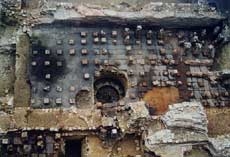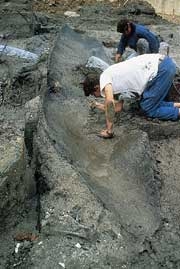- Home
- Archeology in Paris
- Present day research The Regional Archaeology Department
The caldarium of the Vanves baths. Excavation by INRAP.
Photo: © X. Peixoto / INRAP.
Discovery of a dugout canoe during the excavations at Bercy.
Photo: © C. Valero / INRAP.
The Regional Archaeology Department (Service régional de l'archéologie) operates under the aegis of the region's prefect and the Regional Cultural Affairs Director. The job of the department is to implement State policy concerning archaeology, and to inventory, study, protect, preserve and promote the archaeological heritage of the Île de France.
Within the framework of the Law of January 17, 2001 concerning rescue archaeology, the Regional Archaeology Department selects and oversees archaeological excavations that are conducted prior to various territorial construction projects. These include new buildings, roadworks, work on various infrastructures, etc. These excavations are mostly carried out by the National Rescue Archaeology Research Institute (Institut national de recherches archéologiques préventives-INRAP). Under the terms of an agreement created by the Ministry of Culture, the Commission du Vieux Paris is also authorised to conduct rescue archaeological work, and the regional department regularly uses the Commission's archaeologists. They also contribute to the updating of the National Archaeological Map, when it comes to identifying and mapping sites found within Paris.
In addition, a number of scientists from France's universities, the CNRS (National Centre for Scientific Research), the Ministry of Culture, and the Commission du Vieux Paris carry out collaborative research projects within Paris. These projects are on a wide variety of topics, including food and eating habits of the Gauls, leatherworking, ceramics from antiquity up to the Middle Ages, archaeological site mapping, hydraulics, the geomorphology of the Seine, and so on.
Our knowledge of the history of Paris continues to grow thanks to large-scale archaeological campaigns, but also through small sampling operations, overseeing earth- and construction work, and documentary research.

